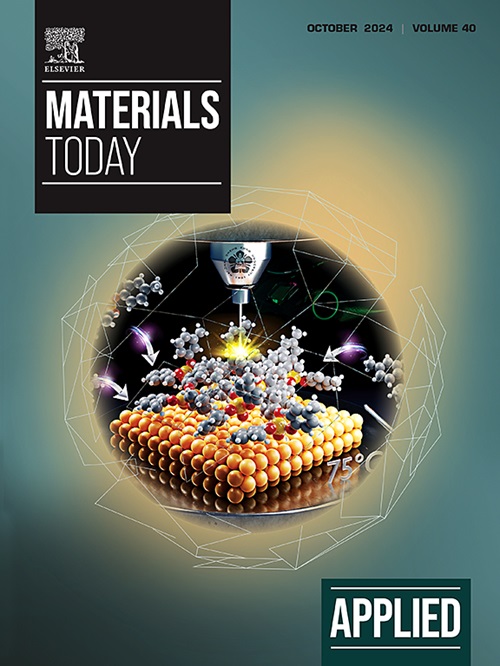4D printing thermo-magneto-responsive PETG-Fe3O4 nanocomposites with enhanced shape memory effects
IF 6.9
2区 材料科学
Q1 MATERIALS SCIENCE, MULTIDISCIPLINARY
引用次数: 0
Abstract
In this groundbreaking study, Polyethylene Terephthalate Glycol (PETG)-FeO nanocomposites were developed for 4D printing, incorporating iron oxide (FeO) nanoparticles into PETG matrix. The research contribution lies in its innovative approach to enhancing the shape memory effect (SME) through thermo-magnetic responsiveness, positioning PETG-FeO as a revolutionary material in smart additive manufacturing. The composites were synthesized using a melt mixing method, followed by 3D printing into specimens for comprehensive evaluation through dynamic mechanical thermal analysis (DMTA), scanning electron microscopy (SEM), and uniaxial tensile tests. The findings revealed that the incorporation of FeO nanoparticles significantly boosts the composites’ storage modulus and glass transition temperature, indicative of improved stiffness and thermal properties. Notably, the 15 % FeO composite emerged as the optimal blend, exhibiting the highest tensile strength and a favourable balance between mechanical integrity and flexibility. A key result was the enhanced SME under both thermal and magnetic stimuli, with recovery efficiency and speed escalating with nanoparticle concentration. This advancement underscores the potential of PETG-FeO nanocomposites in fabricating smart structures capable of environmental adaptability, paving the way for impacts in biomedical, aerospace, and robotic devices. Through this work, a new paradigm in material functionality for 4D printing has been established, demonstrating the viability of magnetic nanoparticle integration for added smart capabilities.具有增强形状记忆效应的 4D 印刷热磁响应 PETG-Fe3O4 纳米复合材料
在这项突破性研究中,开发了用于 4D 打印的聚对苯二甲酸乙二醇酯(PETG)-氧化铁纳米复合材料,在 PETG 基体中加入了氧化铁(FeO)纳米颗粒。该研究的贡献在于采用创新方法通过热磁响应性增强形状记忆效应(SME),从而将 PETG-FeO 定位为智能增材制造领域的革命性材料。研究采用熔融混合法合成了复合材料,然后将其三维打印成试样,通过动态机械热分析(DMTA)、扫描电子显微镜(SEM)和单轴拉伸试验进行综合评估。研究结果表明,加入氧化铁纳米颗粒后,复合材料的储能模量和玻璃化转变温度显著提高,表明刚度和热性能得到改善。值得注意的是,15% 的氧化铁复合材料是最佳混合物,具有最高的拉伸强度,并在机械完整性和柔韧性之间实现了良好的平衡。一个关键结果是在热刺激和磁刺激下都增强了 SME,恢复效率和速度随纳米粒子浓度的增加而提高。这一进展凸显了 PETG-FeO 纳米复合材料在制造具有环境适应能力的智能结构方面的潜力,为其在生物医学、航空航天和机器人设备中的应用铺平了道路。通过这项工作,为 4D 打印的材料功能建立了一个新的范例,证明了磁性纳米粒子集成增加智能功能的可行性。
本文章由计算机程序翻译,如有差异,请以英文原文为准。
求助全文
约1分钟内获得全文
求助全文
来源期刊

Applied Materials Today
Materials Science-General Materials Science
CiteScore
14.90
自引率
3.60%
发文量
393
审稿时长
26 days
期刊介绍:
Journal Name: Applied Materials Today
Focus:
Multi-disciplinary, rapid-publication journal
Focused on cutting-edge applications of novel materials
Overview:
New materials discoveries have led to exciting fundamental breakthroughs.
Materials research is now moving towards the translation of these scientific properties and principles.
 求助内容:
求助内容: 应助结果提醒方式:
应助结果提醒方式:


